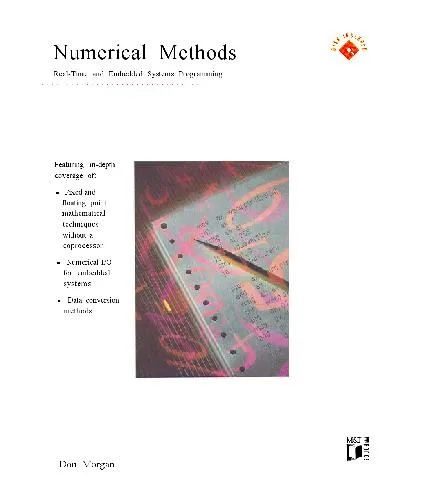Designing Embedded Systems with the SIGNAL Programming Language: Synchronous, Reactive Specification
4.0
بر اساس نظر کاربران

شما میتونید سوالاتتون در باره کتاب رو از هوش مصنوعیش بعد از ورود بپرسید
هر دانلود یا پرسش از هوش مصنوعی 2 امتیاز لازم دارد، برای بدست آوردن امتیاز رایگان، به صفحه ی راهنمای امتیازات سر بزنید و یک سری کار ارزشمند انجام بدینکتاب های مرتبط:
مقدمهای بر کتاب "Designing Embedded Systems with the SIGNAL Programming Language: Synchronous, Reactive Specification"
کتاب "Designing Embedded Systems with the SIGNAL Programming Language: Synchronous, Reactive Specification" نوشته عبدولایه گماتی، یکی از منابع ارزشمند در حوزه طراحی سیستمهای نهفته است. این کتاب با تمرکز بر زبان برنامهنویسی SIGNAL، به صورت جامع به جنبههای نظری و کاربردی طراحی سیستمهای نهفته میپردازد. زبان SIGNAL که بهطور خاص برای مشخصهسازی سیستمهای همزمان و واکنشی طراحی شده است، ابزار قدرتمندی برای تحلیل و ساختاردهی این نوع سیستمها فراهم میکند.
خلاصهای جامع از کتاب
این کتاب شامل ترکیبی از مفاهیم نظری و پیادهسازیهای عملی است و به برنامهنویسان، مهندسان سیستم و دانشجویان این امکان را میدهد که با اصول طراحی سیستمهای نهفته آشنا شوند. کتاب شامل توضیحات دقیقی درباره مفاهیمی مانند هماهنگی، واکنشپذیری و برنامهنویسی همزمان است و تأکید خاصی بر استفاده از زبان SIGNAL دارد که یک زبان برنامهنویسی سطح بالا برای مشخصهسازی و مدلسازی سیستمهای پیچیده میباشد.
نویسنده، مفاهیمی مانند مدلسازی زمانی، شبیهسازی سیستمها و تأیید رسمی ویژگیهای سیستم را بررسی میکند. این مباحث به گونهای ارائه شدهاند که با دانش پایهای در زمینه سیستمهای نهفته قابل درک هستند. علاوه بر آن، مثالهای واقعی و پروژههای کاربردی در کتاب گنجانده شدهاند تا خواننده بتواند مفاهیم را در عمل به کار بگیرد.
نکات کلیدی از کتاب
- توجه به مفاهیم همزمانی و واکنشپذیری در طراحی سیستمهای پیچیده
- معرفی زبان SIGNAL به عنوان ابزار قدرتمند در طراحی سیستمهای نهفته
- پیادهسازی فرآیندهای شکلی برای تأیید رسمی ویژگیهای سیستمها
- کاربرد عملی SIGNAL در شبیهسازی و تحلیل زمانبندی
- ارائه مثالهای عملی و پروژههای واقعی برای درک بهتر مفاهیم
نقل قولهای معروف از کتاب
"Synchronous and reactive programming challenges us to redefine how we think about causality, time, and computation for modern embedded systems."
"The SIGNAL language provides a bridge between high-level modeling and low-level implementation, making it a cornerstone for reactive system design."
چرا این کتاب ارزشمند است؟
این کتاب برای چندین دسته از مخاطبین ارزشمند است: متخصصانی که نیازمند ابزار قدرتمند و رسمی برای طراحی سیستمهای نهفته هستند، مهندسان نرمافزار که میخواهند در برنامهنویسی واکنشپذیر و همزمان مهارت کسب کنند، و دانشجویانی که به دنبال مفاهیم قوی و مؤثر برای یادگیری طراحی سیستمهای نهفته میباشند.
برجستگی اصلی این کتاب در استفاده از زبان SIGNAL برای ایجاد پل میان مدلسازی سطح بالا و پیادهسازی سطح پایین است. این ویژگی نه تنها به کاهش پیچیدگی طراحی کمک میکند، بلکه باعث افزایش قابلیت اطمینان سیستمهای طراحیشده نیز میشود.
Introduction
Embedded systems are at the heart of modern technology, found in devices ranging from simple household appliances to critical aerospace systems. Designing these systems requires precision, efficiency, and a methodical approach that ensures both functionality and reliability. "Designing Embedded Systems with the SIGNAL Programming Language: Synchronous, Reactive Specification" is a definitive guide that dives into the details of creating embedded systems using the SIGNAL programming language - a powerful tool for specifying systems with a synchronous and reactive paradigm.
This book serves as a comprehensive resource for software developers, researchers, and engineers who wish to understand and apply SIGNAL for the design of embedded systems. With its ability to handle concurrency, determinism, and reactivity elegantly, SIGNAL enables practitioners to model complex behaviors while ensuring correctness. This introduction explores the essence of the book, key insights, famous quotes, and the significance of this body of work in tackling the growing challenges of embedded system design.
Summary of the Book
The book is meticulously crafted to serve both as an educational resource and a practical reference. Its content spans from foundational concepts to advanced topics, making it accessible to beginners while remaining valuable for experienced professionals. The overarching goal of the book is to familiarize readers with the SIGNAL programming language, while also addressing broader considerations in embedded system design.
The text begins by introducing synchronous programming and its relevance in the domain of embedded systems. It highlights the reactive nature of these systems, which are designed to respond to external stimuli in a predictable and timely manner. The SIGNAL language is presented as a solution for modeling the temporal and behavioral properties required in such systems. The reader is guided through its syntax, semantics, and unique features, including its ability to manage concurrency, handle deterministic synchronization, and specify timing constraints effectively.
Practical examples are interwoven throughout to demonstrate how SIGNAL can be applied to real-world problems, such as safety-critical systems, process control, and communication protocols. The book emphasizes the importance of formal methods in specifying, analyzing, and verifying system behavior, ensuring that designs meet their specifications before implementation. Topics such as system modularity, refinement, and compositional design are explored in depth to illustrate the benefits of structured development practices.
By the end of the book, readers will have a deep understanding of the SIGNAL language, the theoretical principles underlying reactive systems, and the practical tools needed to apply these concepts in their own projects.
Key Takeaways
- A comprehensive introduction to the SIGNAL programming language and its role in designing synchronous, reactive systems.
- A solid understanding of how to design and verify embedded systems using formal methods.
- Insights into handling concurrency, synchronization, and timing constraints in complex systems.
- Practical examples and use cases for applying SIGNAL in real-world contexts.
Famous Quotes from the Book
"In embedded systems, correctness is not a luxury; it is a necessity."
"The SIGNAL language offers not just a way to express computations, but a framework to reason about their interactions in time and space."
Why This Book Matters
As embedded systems grow increasingly complex, the tools and methodologies used to design them must evolve accordingly. This book bridges the gap between theory and practice, empowering practitioners to tackle modern challenges in system design. The SIGNAL language, with its emphasis on reactivity and determinism, provides a superior approach to dealing with the intricacies of embedded systems.
This book matters because it arms readers with the knowledge to design systems that are not only functionally correct but also efficient, maintainable, and reliable. As embedded systems continue to influence industries such as automotive, telecommunications, and healthcare, the principles and practices outlined in this book will remain valuable for years to come.
Whether you're seeking to master the SIGNAL language, explore synchronous programming, or develop cutting-edge embedded systems, this book is an essential addition to your library.
دانلود رایگان مستقیم
شما میتونید سوالاتتون در باره کتاب رو از هوش مصنوعیش بعد از ورود بپرسید
دسترسی به کتابها از طریق پلتفرمهای قانونی و کتابخانههای عمومی نه تنها از حقوق نویسندگان و ناشران حمایت میکند، بلکه به پایداری فرهنگ کتابخوانی نیز کمک میرساند. پیش از دانلود، لحظهای به بررسی این گزینهها فکر کنید.
این کتاب رو در پلتفرم های دیگه ببینید
WorldCat به شما کمک میکنه تا کتاب ها رو در کتابخانه های سراسر دنیا پیدا کنید
امتیازها، نظرات تخصصی و صحبت ها درباره کتاب را در Goodreads ببینید
کتابهای کمیاب یا دست دوم را در AbeBooks پیدا کنید و بخرید
1263
بازدید4.0
امتیاز0
نظر98%
رضایتنظرات:
4.0
بر اساس 0 نظر کاربران
Questions & Answers
Ask questions about this book or help others by answering
No questions yet. Be the first to ask!














